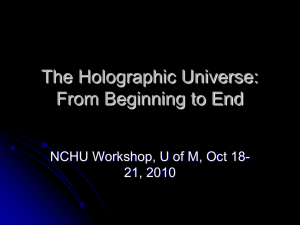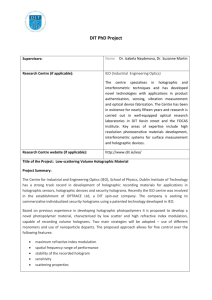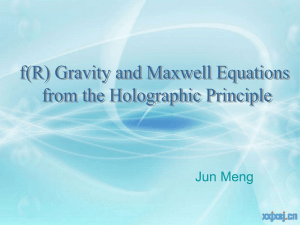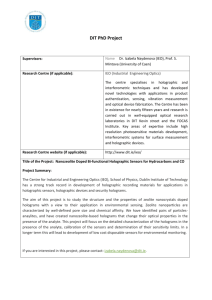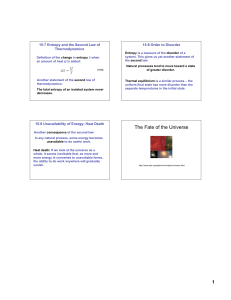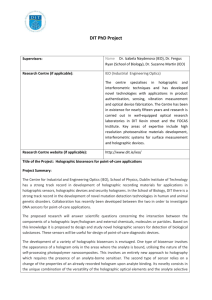The Holographic Principal and its Interplay with Cosmology T. Nicholas Kypreos
advertisement
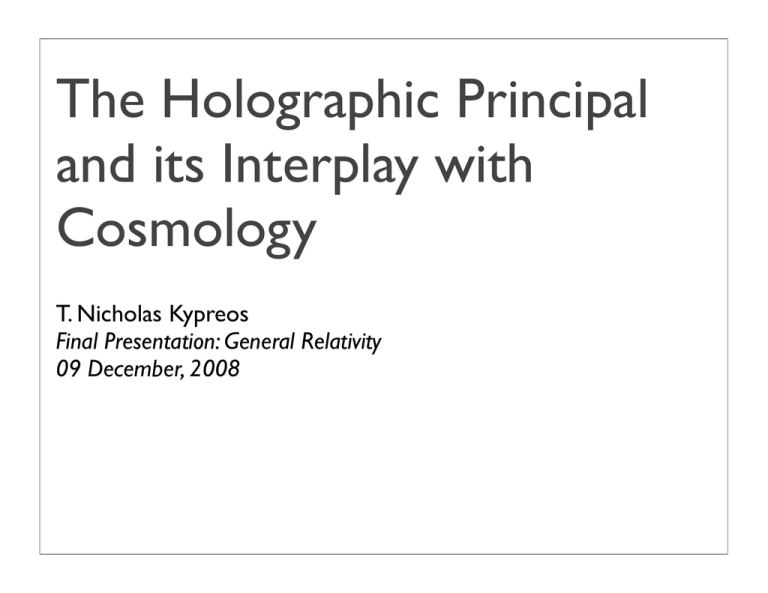
The Holographic Principal and its Interplay with Cosmology T. Nicholas Kypreos Final Presentation: General Relativity 09 December, 2008 What is the temperature of a Black Hole? for simplicity, use the Schwarzschild metric ! ds = − 1 − 2 2M r " dt2 + 1 1− 2M r dr2 + r2 dΩ take a scenario with a stationary observer just outside of the horizon such that rewrite the metric t τ= 4M ρ = 2u u2 r = 2M + 2M 2 u 2 2 2 ds2 = − dt + 4du + dX ⊥ 4M 2 2 ds2 = −ρ2 dτ 2 + dρ2 + dX⊥ this configuration is known as Rindler Coordinates T.N. Kypreos 2 [1],[3],[6],[7] Unruh effect An observer moving with uniform acceleration through the Minkowski vacuum ovserves a thermal spectrum of particles ! β(u) = 2πρ = 4πu = 4π 2M (r − 2M ) this is subsequently red-shifted " ! β(r ) = 4π 2M (r − 2M ) ! take the limit as 1− 2M r! 1− 2M r √ β(r → ∞) = 4π 2M r ! R = 2M β(r! → ∞) = 8πM at the horizonʼs edge 1 recalling thermodynamics β(r → ∞) = kT = 8πM 1 !c3 finally, the temperature T = 8πk M T = 8πGM kb b ! T.N. Kypreos 3 human units What is the Entropy? dQ dS = = 8πM dQ T letting kb = 1 exploiting the equivalence principal, take theenergy added as a change in mass dM dS = 8πM dM = 8πd(M ) R = 2M 2 A S = πR = 4 • the entropy of the black hole is 2 proportional to the area of the horizon T.N. Kypreos 4 Introduction • holographic principle is a contemporary question in physics literature ( see references ) • holographic principal provides complications when being connected to cosmological models • will explore some of the successes, failures, and “paradoxes” of the holographic principle Example with GUT scale inflation: 2 72 S ∼ T 3 L3H ∼ 1099 T ∼ 10−3 LH ∼ 1036 A ∼ LH ∼ 10 Not consistent with Holographic Principle T.N. Kypreos 5 The Holographic Principle Seemingly Innocuous Statment: The description of a spatial volume of a black hole is encoded on the boundary of the volume. Extreme Extension: The universe could be seen as a 2-D image projected onto a cosmological horizon. T.N. Kypreos 6 Expanding Flat Universe • common solution to any intro to general relativity text -including our own • provides simple test for the holographic principal Start with the metric for a flat, adiabatically expanding universe: ds2 = −dt2 + a2 (t)dxi dxi ρ̇ + 3H(1 + γ) = 0 ρ T.N. Kypreos ȧ where H = a 7 p = γρ Radiation Dominated (FRW) Universe Solutions to this are known... some highlights: a(t) = t 3 3(γ+1) let a(1) = 1 ρ= 4 1 2(1+γ)2 a3(1+γ) To get the size of the universe, integrate a null geodesic to the boundary (which can be chosen as radial) ! t dt! dt χH (t) = a(t) 0 a(t! ) = a(t)rH (t) such that rH (t) = a(t) So what’s the answer? These solutions will vary depending on the value of gamma, so let’s take γ > − 13 . 3(γ + 1) χH = a(t)rH (t) = t 3γ + 1 integral starts a 0 -- looks like we cheated We get around the singularity at 0 by starting the integral at t=1. This corresponds to Planck time. • T.N. Kypreos 8 Donʼt Forget about the entropy At the start time, we have χH (1) ∼ 1 This is at least getting us somwhere. We can use this to limit the entropy density since the volume of space will also be ~1 2 ∼ χ we know the area of the horizon H S 2 =σ∼1 ∼ σrH and the entropy of the horizon A Recall this is an adiabatic expansion... 3 γ−1 S rH (t) ∼ σ 2 = σt γ+1 A χH Holographic Principle is upheld T.N. Kypreos 9 What does this mean? • found a case where the holographic principal holds... • solution holds for −1 < γ < 1 T.N. Kypreos 10 Closed Universe • closed universes tend to collapse... • worth verifying with the Holographic Principle... ds2 = −dt2 + a2 (t)(dχ2 + sin2 χdΩ) S 2χH − sin 2χH =σ 2 A 2a (χH ) sin2 χH • consider the case where the universe dominated by ! χis " H 2 p ! ρ a = a sin dark matter: max 2 area vanishes at χH = π • • χH = π is regular... Holographic Principal is violated T.N. Kypreos 11 What Does All This Math Tell Us? • topologically closed universes could not exist • collapsing universes cannot happen in a manner that preserves the second law of thermodynamics • • entropy is always increasing if the universe is collapsing, the surface area must eventually vanish T.N. Kypreos 12 So what about Thermodynamics? • in the advent that the holographic principal cannot be consistent with the second law of thermodynamics, there are two choices • • holographic principal is wrong? thermodynamics is wrong? • propose “Generalized Second Law of Thermodynamics” • effectively adding a correction term to work around writing off the entropy inside a black hole as unmeasurable S = SM + SBH ! • can no longer access the quantum states inside T.N. Kypreos 13 Cosmological Inflation • holographic principal and inflation are compatible depending on the rate of inflation • could be that holographic principal bounds inflation or vice versa • currently holographic bounds put S ≤ 10120 compared to current observations that give S ≤ 1090. T.N. Kypreos 14 Flat Universe Revisited Λ < 0 • Lets take the situation where we have the universe extending into Anti de Sitter Space with the flat universe from earlier. ρ0 ρ = 3(γ+1) − λ a ! ρ0 2 − λa rewriting the Friedman equation yields ȧ = ± a3(γ+1) ρ0 = λa3(γ+1) ! " γ solving for the turning points yields B 2(γ+1) , 1/2 √ LH (ȧ = 0) = 3(γ + 1) λ this has turning points when T.N. Kypreos 15 Revenge of the Flat Universe leaving... LH ∼ λ−(3γ+1)/6(γ+1) " 1 • • holographic principle becomes violated • most of the success of the holographic principle comes from Anti de Sitter space / Conformal Field Theory (AdS/CFT) Correspondence violation for holographic principal happens well before planck limit • T.N. Kypreos 16 Conclusions • holographic principle discovered in uncovering the temperature of a black hole • has found a home in string theory and quantum gravity research ( AdS/CFT correspondence) • seems to have more of the characteristics of an anomaly than cause for quantum gravity • does not work cosmologically for topologically closed universe / flat universe going to Anti de Sitter Space T.N. Kypreos 17 References 1. W. Fischler, L. Susskind, Hologragphy and Cosmology, hep-th/9806039 2. Edward Witten, Anti De Sitter Space And Holography, hep-th/9802150 3. Nemanja Kaloper, Andrei Linde, Cosmology Vs Holography, hep-th/9904120 4. http://apod.nasa.gov/apod/ap011029.html 5. http://www.nasa.gov/topics/universe/features/wmap_five.html 6. G ’t Hooft, Dimensional Reduction in Quantum Gravity, gr-qc/9310006 7. Carroll, Spacetime and Geometry, 2004 Pearson 8. http://www.nasa.gov/images/content/171881main_NASA_20Nov_516.jpg 9. Ross, Black Hole Thermodynamics, hep-th/0502195 T.N. Kypreos 18 Backup Slides T.N. Kypreos 19 Phase space of solutions T.N. Kypreos 20 Laws of Black Hole Thermodynamics Stationary black holes have constant surface gravity. κ 1. dM = dA + ΩdJ + ΦdQ 8π 2. The horizon area is increasing with time 3. Black holes with vanishing surface gravity cannot exist. http://en.wikipedia.org/wiki/Black_hole_thermodynamics T.N. Kypreos 21
